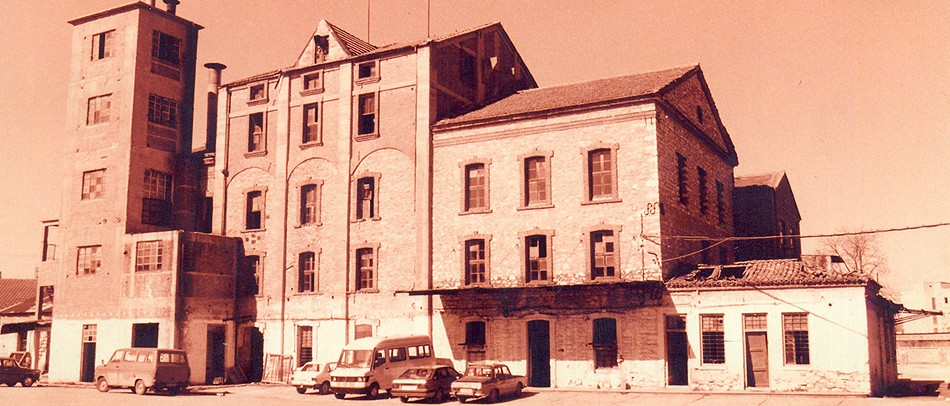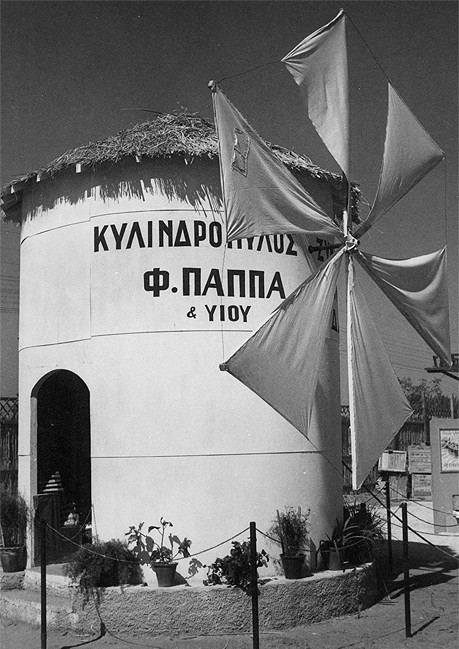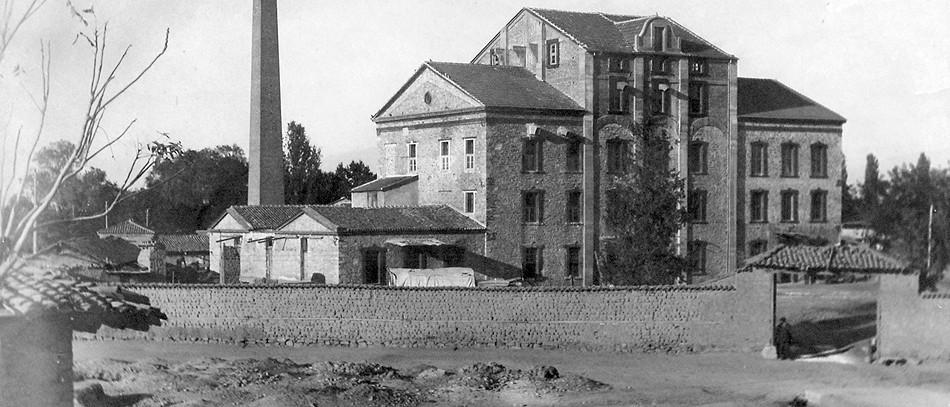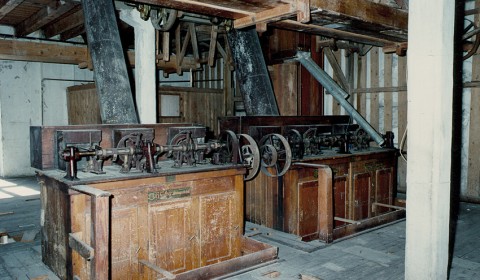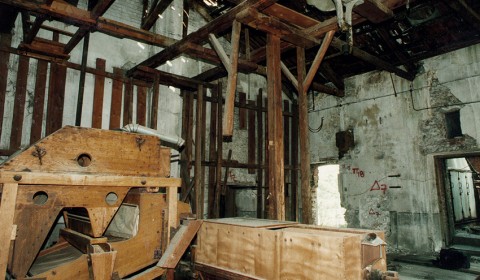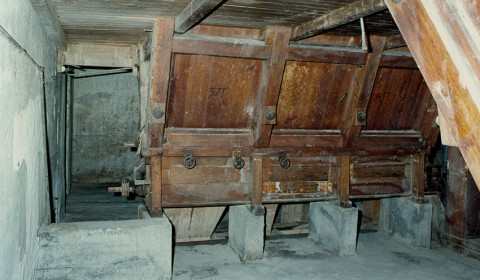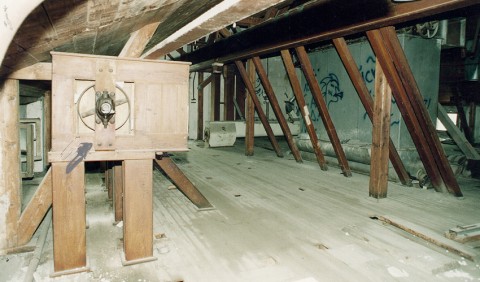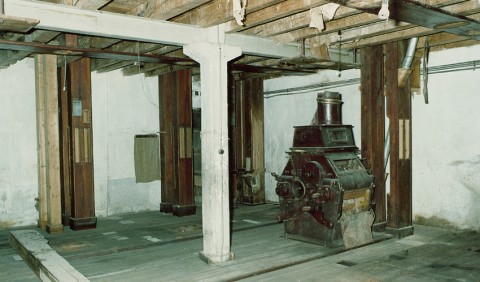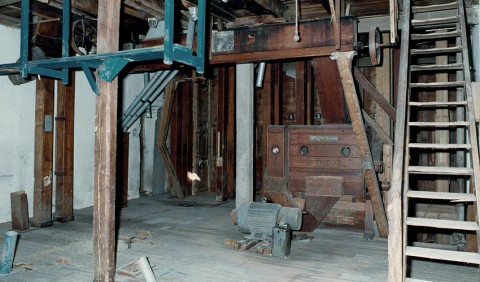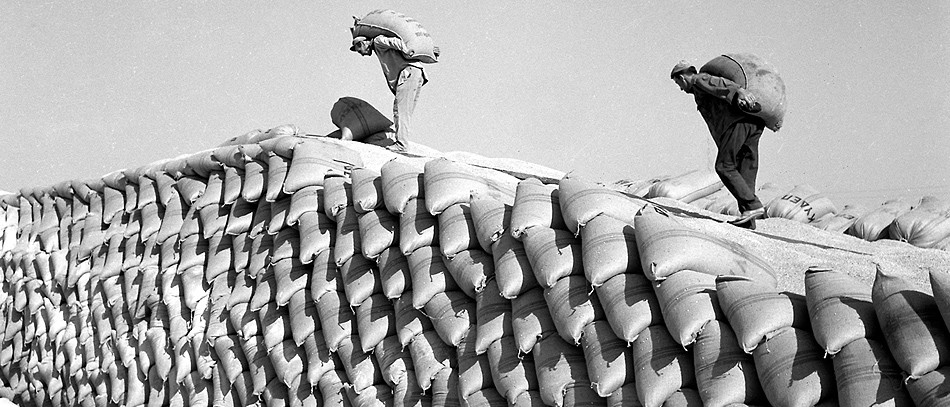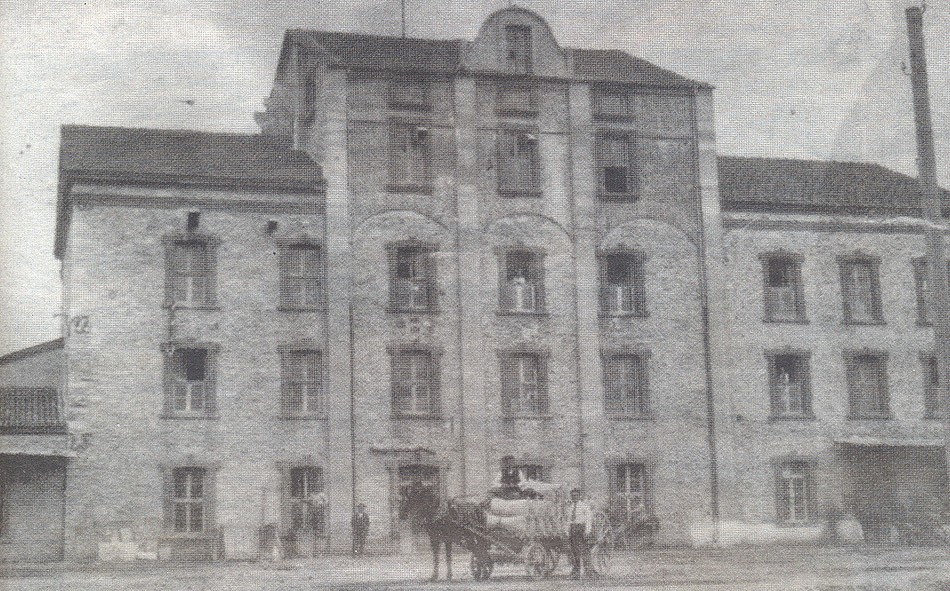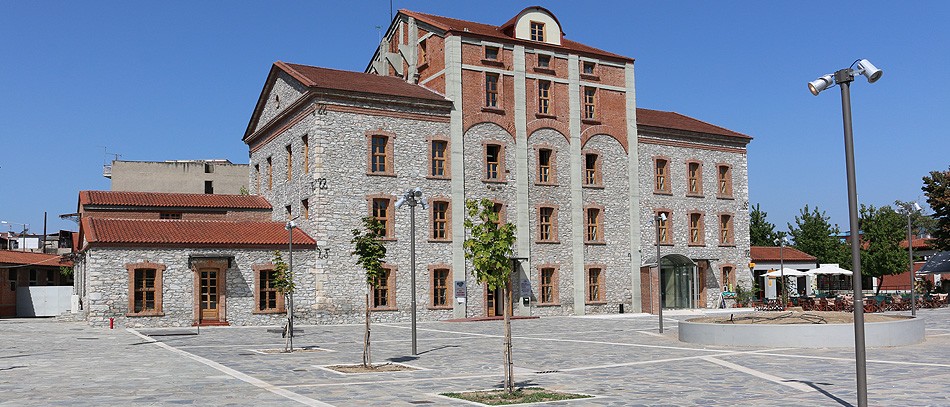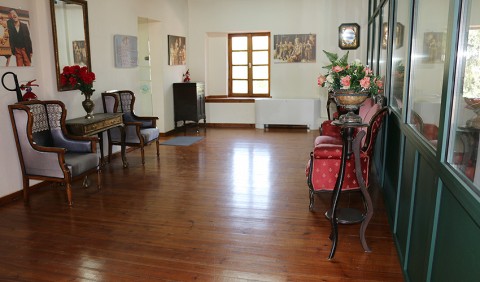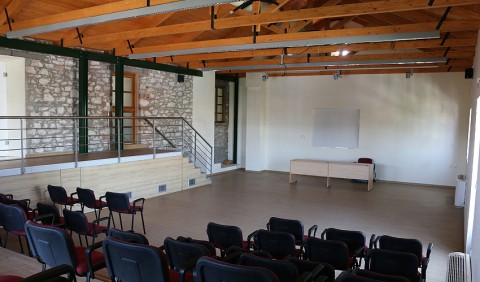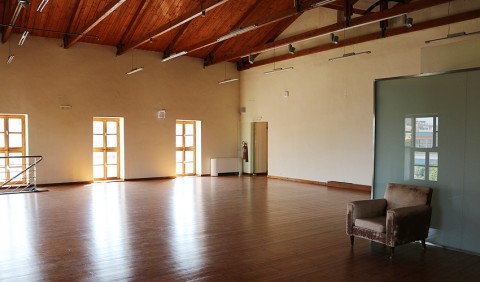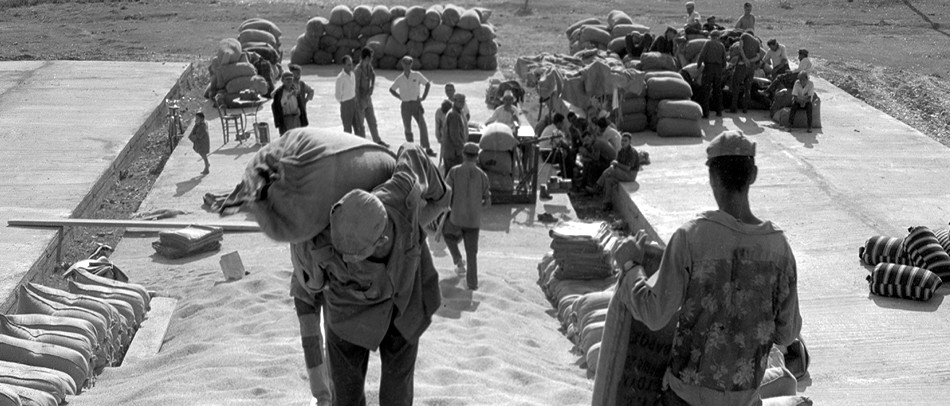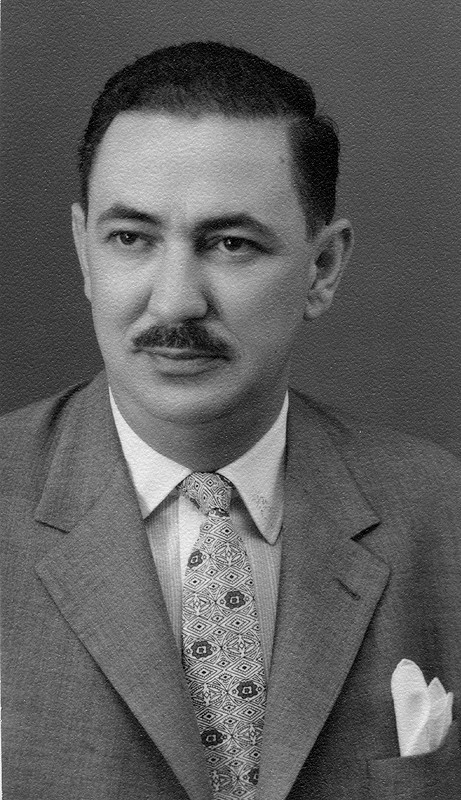The mill was a watermill, windmill, roller in successive phases of its development since its foundation in the late 19th century until the 1980s that stopped its activity.
The Mill's history begins in 1893, when our townsmen Konstantinos Pappas, Konstantinos Skalioras and Christos Dimitriades purchased a 10-acre area in the district of Tabakiκa, established the enterprise and put the mill in motion, at an era when Larissa still maintained the colour of a Turkish city.
This mill however is different from the others as it was powered by steam, something which constituted a significant technological leap for its era.
Active men and capable entrepreneurs, they soon managed to establish a branch in Volos and distribute their production through its port to the entire Greece.
In the beginning of 1900, Fotis Pappas, the nephew of Konstantinos Pappas who had been working by the side of his uncle from the age of 10 learning the secrets of the trade, took over.
Fotis Pappas evolves into the enterprise's leader, leading the Mill tο its rise.
The flour production is increasing and the Mill of Pappa becomes the main feeder entire Thessaly.
Fotis Pappas had faceted activity and citizenship. He offered the Macedonian struggle, was president of the Commercial Association of Larissa, spearheaded the effort water and lighting of the town, alderman elected.
The latest figurehead of the mill and successor of Fotis Pappas was his son, Angelos Pappas. Studyingeconomics at the University of Athens, he took over leadership of the company in early 1960 and remained until its closure in 1983.
In the late 19th century, the milling of cereals from stone mortars and pestles passed to mills, watermills and windmills.
Thessaly, because of the abundance of water, had many mills in Portaria, in Gonnoi and Sykourio. In Larissa, on the right bank of the Peneus river, beyond the district of Ambelokipi, operate the first mills of Tsimpouki and Dimitriadis, where there were narrow and irregular streets with many tsikmaz.
So, in this valley city in 1892 comes from Epirus Konstantinos Pappas with 40 other workers from Gjirokastra. Constantinos Pappas then buys the district Tampakika from the landowner Roussopoulos, and other 4 from the Mufti Hasan Efendi foundations, the place of the old Turkish cemetery.
The 10,000 sq.m. land purchased by Konstantinos Pappas located in the district Tampakika which was a popular district and during the Ottoman domination. According to the contract of 1893 signed at notary's Agathangelos Ioannidis notary, this land's owner officially becomes Pappas Konstantinos and his partners,Skalioras and Dimitriadis.
The partners conclude a partnership trading under the name Dimitriadis - Pappas - Skalioras and commercial capital 300,000 GRD.
The area around the mill was full of thistles, ditches and garbage. In lanes and impasses were many infamous houses with criminals, drunks, underworld people generally. This whole area strongly maintained the color of the Turkish city.
The city had little population, but grain production was great in wide region thanks to Spiros and Panagis Charokopou who made our valley one of the largest granaries of the country.
So close to the fortress of the city and the Bezesteni functions in 1893 the mill of Pappas. But, this mill differs from the usual ones because it moves with steam, which was a major technological leap for that era.
The company's goal, which was established in 1893, was the purchase of cereals and their resale after processing into flour or pasta. Alongside the three partners found a smart solution, to create a branch in Volos where only watermills functioned those days. Besides these, Volos with its port would facilitate trade to Piraeus and to the rest of Greece.
The Mill of Pappas because of steam and because of machines that is equipped, is a pioneer.
In 1897 misfortunes and tragic events of war harmed the production and trade of grain. The company incurred losses and forced to resort to borrowing.
In 1899 the Company financed by a loan of 250,000 drachmas from the National Bank. This loan demonstrates that the mill of Pappas was the largest industrial enterprise of the age.
In 1899 Christos Dimitriadis left the company due to old age and poor health and the mill remains in the other two, Pappas and Skalioras. Although, the production has increased and a bakery started operating in the mill, just where today stands the theater of Milos. Larissa citizens knead but mostly eat white bread with flour produced by Pappas. The mill's features are the superior quality and increasing production even though at that time people used to knead, since bread was not manufactured possession.
In midd 1900 Skalioras left too and business stays exclusively in Pappas family, which has grown as the nephews of Constantine Pappas, Michael and Fotios, have come and worked. Fotios used to work hard and studied at Commercial School of Volos, acquiring administrative capacities.
Towards the end of the decade, Fotios takes a leading role. Meanwhile, scientific personnel undertake the installation of machines in the mill. University Graduates as Constantine Sarimveis, have the technological supervision of the mill. G. Papahristos, the last miller (1910-1983), gives us enough information about the mill and its time. It is the time that Fotios Pappas works with the Macedonian Association for the liberation of Macedonia.
With the dash of Greek army from Melouna supplies with flour all ovens to produce "kouramanes" and ships' biscuits. The mill collaborates with the mayor Michael Sapkas, contacts Paulos Melas, gives, offers and helps the Greek army.
In Larissa, after Turkish occupation, the mill is a landmark of economic development and progress. According to information from the caretaker Ioannidis, the wages in 1905 was 3.20 drachmas and reached 5.40 drachmas in the years 1910 to 1915.
The production in flour was 45 kilos per hour and there were two working shifts. On August 11, in 1918 a partnership was constituted under the name F. and M. Pappas and A. Makris based in Larissa. The purpose of the new company was the transformation of grain into flour and their trade.
Fotis is appointed as the director and manager of the company and owns 38% share. The others share the rest 62%. As cashier is defined A. Makris, who resigned a year later for unknown reasons.
The mill continues until 1920 its upward trend and evolution when it was destroyed by fire due to foreign troops stationed in Larissa. Many want the fire to be the result of actions of Venizelos in response to the royalist feelings of Pappas Konstantinos, who often visited the palace and met Prince Nicholas in the famous garden of the Royal Palace where the lodge was accompanied by Michael Sapkas and other royalists of Larissa. With the destruction expires and the first session of the mill. The local economy receives a powerful blow as it lost a major industrial unit in the region.
In 1921 the Mill reconstructed and operated under the name of Fotis and Michael Pappas. The new mill operation phase is characterized by the dynamic spirit and the modern conception of the successors of Constantinos Pappas and mainly from Fotios personality, who monitored the development of technology in the flour industry.
The new company is a partnership, where Fotios was holding the 55% and Michael's cousin the 45%. Fotios is the manager and cashier while Michael holds the economic book of the company.
In 1925 Fotios Pappas purchase from the Municipality in Tampakika a 2.203 sqm of land, with the price of 12,000 drachmas to expand the facilities of the mill.
In 1930 Michael Pappas buys 16,000 drachmas from the Municipality of Larissa and so the plot of land spreading. The plans of the mill from 1927 are preserved largely shown in detail the entire mill which drew up the German House construction AMME-LUTHER.
According to the report of the National Bank on 02.04.1930: "The mill is automatic, made of fine materials with electric installation, installation of lightning conductors, network Fire and generally all that required by today's science." The new 3062 sq.m total building area is a five floors tower, warehouses, internal combustion machines with metal sleeves, stone separators, color, centrifuges, dryers, grain brushes, simigdalomichanes, charmanieres flour, lift.
In line with information drawn from the millworker Giannis Papachristos "from 1910 the mill became a roller machine with tractor, in 1928 were making the best semolina, used to feed 30 families until 1930 and got awarded in Italy. The mill's machines were mady by fine wood". The other mills in the region of Tsimpouki and G. Kalyvas can not withstand competition.
The superiority of the Mill of Pappas is obvious for the following reasons:
The Mill is located in the city center which is the largest wheat plainthe quality of wheat produced is excellent, with high quality flour so the world now can and eats no longer black but white bread
the good transport system of Larissa, which is located in the center of the country,helped very much.
All these reasons madee the mill of Pappas a big industry, with big production capacity and high quality flour.
All weighers, the scribes, craftsmen, and assistants, caretakers were in uninterrupted operation while shouting, laughing and swearing with the sounds of the machines give a special charm to the mill for almost 24 hours. Everybody ran to catch production. According to information, the daily time was not enough to cover production.
So, Fotios Pappas having since 1927 ensured the support of large wheat industries such as CHASON from Thessaloniki and having secured bank loans, requests for a new flour industry authorization. The permission was given and the mill managed to serve the market with high quality flour and inexpensive. The mill serves bakers, merchants and the remaining consumers who at the time was usual to ferment at home. So, almost half of Larissa citizens eat bread.
So, white bread was produced by the mill of Pappas. Pappas proceeds on wheat imports from Canada, Argentina and other foreign countries in order to have wheat sufficiency, as domestic production is not sufficient and merchants from Athens, Piraeus and Thessaloniki were a serious obstacle for the evolution and growth of the mill, since they determined exclusively on prices and the movement of grain.
Those days, the mill used 25% wheat domestically and 75% imported. This move by Fotis Pappas was necessary, since breaking the monopoly of wheat production trading, helps local production and the cereal. This move made Fotis Pappas more beloved to Larissa citizens. Fotis is known and beloved since the Macedonian Struggle. Also, he was the first adviser of Greek Red Cross supporter of refugees in 1922.
Fotios Pappas was appreciated by all the city. He used to help refugees, provide work, makes countless donations to foundations, churches, associations sufferers. He shows interest to the staff of the mill.
During the 1st of May and other celebrations, road trips were organized, employers and workers were spending time together. Giving gifts and other benefits when Fotios learns that a staff member is facing an extraordinary pleasant or unpleasant event like wedding or illness, demonstrating alongside the tireless activity as a businessman and the other side of, humanitarian.
And while the law does not oblige the gift of Christmas and Easter, Fotios Pappas was the first who established in 1930 the Easter and Christmas gift for the employees. The city recognizes his social activity and honored him repeatedly with offices such as the Municipal Director and the Chairman of the Municipal Council.
1940-1941. The occupation from the Germans and Italians will bring the requisition of the mill and damages in several places. Continues nevertheless its function, because the mill should produce for the German army. Specifically outside the door of the mill, there were German officers who controlled the mill's production. Fotios Pappas was arrested by men of the reserve ELAS and held for some time in the mountain area of Trikala, situated even accused before a military rebels.
The accusation was that he pioneered the realization of a secret meeting of reactionary political and economic factors in Thessaly aiming at a treacherous organization. The trial got postponed due to lack of witnesses and Fotios Pappas was released on the condition that he would remain in the free zone.
G. Papachristos, the last miller of the mill – worked until 1983, refers that the mill is bombarded by the Italians, who made true looting and that with the release of Pappas begins the reconstruction of the mill and the production begins again to rise daily.
In1945 the mill's staff helped to the reconstruction of the mill so as to reach soon to operate with a capacity of 50 tonnes per day. And then always the staff was an ally of the company.
In 1943 the mill continues its upward trend from 1947 until 1983 by Fotis and Angelos Pappas. That time German trainers came to train the staff. Chaus Karm remained for six months in our city technically helping the company. That period, sixty families were living by the mill.
In 1950 inside the mill a pasta factory operates just behind the theater. By this time pasta was imported from Italy, now suitable hoses bring semolina on engines and proper treatment, wool becomes fluid and then after cooling made the macaroni. According to Ioannidis, customers of the mill was still large pasta industries such as MISKO and Avez . However pasta factory did not go, because competition with European countries was tough and the funding conditions very difficult.
In 1960 Fotis Pappas after active citizenship, municipal councilor, president of the City Council and candidate for mayor in the municipal elections of 1954 in which he lost his post by D. Hadjigiannis, delivers the command of mill to his son Angelos, who becomes chairman and CEO of the company.
His wife Aliki becomes vice president and C. Ioannides, C.Chatzigiannis and C. Perdikaris become advisors. Fotios Pappas who supported so much our city, died in 1963. The last years of his life dedicated to the study and culture, helping Filarchaio Thettaliki Company.
In 1967 the mill was converted into a Limited Company "Pappas Flour Industry SA". New facilities and modernization of machinery resulted to daily production rise up to 90 tons.
With 49 staff of mill workers, for twenty years (1960-1980) the mill is the largest flour mill in Thessaly. Angelos Pappas will lead the mill at high altitudes. The staff increased to eighty people.
The daily production reaches 80-90 tonnes with three working shifts. There is, of course, a large grinding capacity and storage. Angelos Pappas company supplies the well-known Greek biscuit industry Papadopoulou, confectionary and the Greek army.
The turnover is 60-70 million drachmas and follows all the latest developments in the field of flour in Switzerland, Germany, England.
It is obvious that the mill with its huge development has contributed to the economy of our region.
In 1974 Angelos son, who studied economics, takes over the company.
But the company has begun to be harmful and is in descending mode.
The dictatorship of Papadopoulos who left the trade free, the low price of flour, the evolution of technology made the machinery of the mill not competitive and productive. The shareholders Angelos and Fotis Pappas make, in 1980 strong>, a last effort to save the mill.
Unfortunately, many problems have led to the dissolution of the Company. So the mill of Pappas after an entire century extinguished and the Pappas are not a miller family any more.
In 1988 the Municipality of Larissa buys the mill and two plots that surrounded it, a total area of 10 924 sq.m.
In 1989 the mill is characterized as a significant and representative sample of traditional building of the 20th century by the Ministry of Culture.
In 2002 a fire will break the link from the chain of local history. The responsibility of arson was attributed to marginal individuals who have never been revealed. The fire destroyed the wooden floors and the roof collapsed on the ground.
Today, after the restoration of the mill, many cultural activities are held. In the mill and around it are housed and operated a dance school , art workshops , a small theater with 150 people capacity , the Municipal Band , a summer cinema , a puppetry.
So today the mill continues to offer things the city differently. Its imposing facade awe visitors, evokes memories of the past and connects the present with the older growth seasons.
The mill of Fotis and Angelos Pappas is a true culture cell and integral piece of the city's history.
- Evening High School of Larissa G. Samaras, A. Gagakis, D. Fakiri, K. Aggeli -
This perspective was intended to highlight not only their professional activity but rather their social promotion.
People with consistency, decency, civility, and morality touched us with the love and kindness shown to all their general mylergates, indigenous, refugees and foreigners.
The prosperity, progress, leadership and organization were key features of the business and were those that helped them create opportunities in life.
People with broad education, employers with a developed sense of responsibility and respect towards employees, society and their country laid the foundations of a modern healthy industry model.
The mill of Pappas was the first important point of the modern period of the city, living piece of history, an important legacy of memories and learning for future generations.
The mill withstood time, from the grindstone until the modern industrial buildings. Steam-mill, roller mill, standing, unique, huge since pre-industrial society of Larissa till today.
Near the city center, behind the bus station, is located the Mill.
The mill grinded thousand tons of milling wheat, soft and hard, and both sufferings, pleasant and unpleasant memories of the life of Larissa.
Prohibitive for all except staff, open to all today, is a real fountain of culture and activities.
Other people during that era, other warehouses in loadings on charmanieres. Other people today in theater halls, dance, cinema ..
During that era, the mill belonged to Pappas, today is common, the property of Larissa citizens.
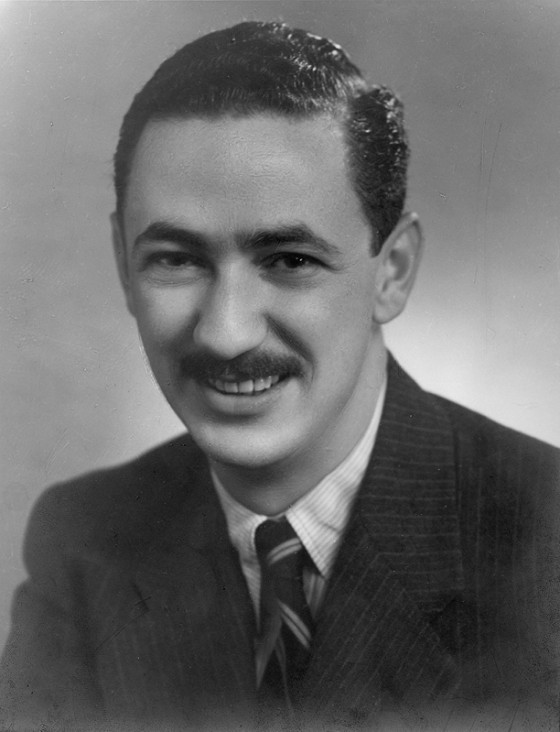 Fotios Pappas
Fotios PappasBorn in Selio in 1876, current Argyrokastro in Albania, originating from Epirus parents.
After his uncle, Constantine Pappas, arrival in Larissa, Fotios comes too at just 10 years old and works in the family business while learning the secrets of milling. After finishing the Commercial School of Volos acquires parallel and administrative capacities.
He offered the Macedonian struggle as a patriot and a member of the Macedonian Association together with the mayor of Larissa, Michael Sapka,who was a Macedonian too. They cooperate with Pavlos Melas who morally and financially support and help the struggle of freedom in Macedonia.
Fotios Pappas was president of the Commercial Association of Larissa, a member of the management of Water and Electrolighting Company of Larissa, chairman of the City Council, first counselor of the Greek Red Cross, mayoral candidate in municipal elections in 1954, a supporter of Filarchaiou Thettalikis Company.
Fotios Pappas gave his name to a street of Larissa. He died in 1963.
Aggelos Pappas - Son of Fotios Pappas
He studied economics at the University of Athens.
He was president and CEO of Pappas Flour Industry SA until 1983. He helped farmers to develop grain growing. He was President of the Association of Industrialists of Larissa and first member of the administration of the Chamber. With his wife Aliki, who was vice president of the company, had two sons, Fotis and Alexanderos, who worked as stockbrokers and did not continue the family tradition.

